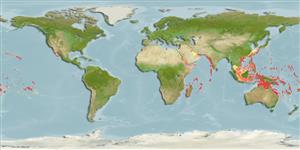Common names from other countries
Classification / Names / Names
Common names | Synonyms | Catalog of Fishes (gen., sp.) | ITIS | CoL | WoRMS
Environment: milieu / climate zone / depth range / distribution range
Ecology
Reef-associated; depth range 0 - 86 m (Ref. 107543). Tropical; 36°N - 34°S, 26°E - 108°W (Ref. 848)
Indo-Pacific: Japan to South Africa and Red Sea to Easter Island. Tropical and subtropical.
Length at first maturity / Size / Weight / Age
Maturity: Lm ? range ? - ? cm
Has a distinctive dark brown coloration with a white oral disc.
Can be found in shallow waters (Ref. 122680). Expands during daytime. Surface is usually pock-marked with barnacles, tube worms, and holes made by Lithophaga sp. (Ref. 130769).
Life cycle and mating behavior
Maturity | Reproduction | Spawning | Eggs | Fecundity | Larvae
Members of the class Anthozoa are either gonochoric or hermaphroditic. Mature gametes are shed into the coelenteron and spawned through the mouth. Life cycle: The zygote develops into a planktonic planula larva. Metamorphosis begins with early morphogenesis of tentacles, septa and pharynx before larval settlement on the aboral end.
Ross, M.A. and G. Hodgson. 1981. (Ref. 8294)
IUCN Red List Status (Ref. 130435)
CITES status (Ref. 108899)
Not Evaluated
Human uses
| FishSource |
Tools
Internet sources
Estimates based on models
Preferred temperature
(Ref.
115969): 24.3 - 28.8, mean 27.5 (based on 724 cells).
Price category
Unknown.
